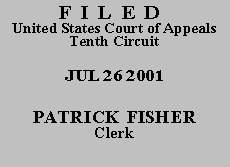

| UNITED STATES OF AMERICA,
Plaintiff-Appellee, v. VICTOR CORNELL MILLER, Defendant-Appellant. |
|
|
UNITED STATES OF AMERICA, Plaintiff-Appellee, v. GEORGE JOHN HANSON, Defendant-Appellant. |
(D.C. No. 99-CR-125-002-C) (N.D. Okla.)
|
We have consolidated these appeals on our own motion. See Fed. R. App. P. 3(b)(2). In appeal No. 00-5142, Victor Cornell Miller appeals from a judgment sentencing him to life imprisonment plus 1,584 months. In appeal No. 00-5149, George John Hanson appeals from a judgment sentencing him to life imprisonment plus 984 months. Both men were tried together and convicted by a jury of crimes arising from a string of robberies. They raise issues relating to their convictions and the calculation of their offense levels under the United States Sentencing Guidelines (USSG).
Appeal No. 00-5142, Victor Cornell Miller
Miller contends that his conviction on Count 15, possession of a firearm during a crime of violence, must be reversed because the district court permitted the government to amend an erroneous cross-reference in the superseding indictment without resubmission to the grand jury. We agree with the district court, however, that the amendment was one of form rather than substance, was not prejudicial to Miller, and did not require correction by the grand jury. See United States v. Pina, 974 F.2d 1241, 1243 (10th Cir. 1992); see also United States v. Leichtnam, 948 F.2d 370, 376 (7th Cir. 1991); United States v. Sobamowo, 892 F.2d 90, 97 (D.C. Cir. 1989).
Relying on Apprendi v. New Jersey, 530 U.S. 466 (2000), Miller next challenges the application of the Armed Career Criminal enhancement in the calculation of his criminal history category. See 18 U.S.C. § 924(e); USSG § 4B1.4. The district court determined that Miller had four prior violent felony convictions and was therefore subject to the enhancement. This finding is not subject to challenge under Apprendi. See United States v. Martinez-Villalva, 232 F.3d 1329, 1331-32 (10th Cir. 2000).
Miller also argues that Apprendi did not permit the district court, following USSG § 2K2.1(c)(1)(B), to cross-reference to two unconvicted homicides as relevant conduct to set the offense level. Miller argues that under Apprendi, these homicides had to be pled in the indictment and proved to the jury beyond a reasonable doubt to permit the cross-reference.(1) Apprendi requires that any fact other than a prior conviction that increases the penalty for a crime beyond the prescribed statutory maximum be submitted to a jury and proved beyond a reasonable doubt. Id. at 490. "Apprendi does not apply to sentencing factors that increase a defendant's guideline range but do not increase the statutory maximum." United States v. Sullivan, 242 F.3d 1248, 1255 (10th Cir. 2001). Due to his prior violent felony convictions, use of which we have already upheld, Miller faced a statutory sentence on Count 16 ranging from a minimum of fifteen years to a maximum of life imprisonment. 18 U.S.C. § 924(e)(1); United States v. Custis, 511 U.S. 485, 487 (1994). The life sentence he received therefore did not exceed the statutory maximum.
Appeal No. 00-5149, United States v. Hanson
Hanson first argues that he should not have been sentenced as a career offender pursuant to USSG § 4B1.1, because he did not have two prior felony convictions for violent or controlled substance offenses. Hanson was not sentenced as a career offender, however; instead, he received a sentencing enhancement as an Armed Career Criminal. The Armed Career Criminal Act (ACCA) applies when a defendant has three previous violent felony convictions committed on occasions different from one another. 18 U.S.C. § 924(e)(1).
Hanson has the three requisite convictions for application of the ACCA. His conviction for first degree robbery committed on December 3, 1982 is counted separately from convictions for first degree robbery and assault with a deadly weapon with intent to kill, which he committed against different victims one day later. See United States v. Lloyd, 13 F.3d 1450, 1454 (10th Cir. 1994). His third violent felony conviction was for escape that occurred October 3, 1990. Although there is no evidence that the escape involved any violence, and the state statute under which he was convicted does not define escape as a violent offense, the escape nevertheless constitutes a violent felony, because "escape is always a violent crime" for purposes of the ACCA. United States v. Springfield, 196 F.3d 1180, 1185 (10th Cir. 1999), cert. denied, 529 U.S. 1029 (2000). Thus Hanson has three prior violent felony convictions, and the enhancement was properly applied.
Finally, Hanson argues that under Apprendi, the jury should have been allowed to determine whether he was subject to the Armed Career Criminal enhancement. As noted above, this argument is barred by our decision in Martinez-Villalva, 232 F.3d at 1131-32.
The judgments of the United States District Court for the Northern District of Oklahoma are AFFIRMED.
Entered for the Court
Circuit Judge
*. This order and judgment is not binding precedent, except under the doctrines of law of the case, res judicata, and collateral estoppel. The court generally disfavors the citation of orders and judgments; nevertheless, an order and judgment may be cited under the terms and conditions of 10th Cir. R. 36.3.
1. Co-defendant Hanson makes the same argument, which fails for the same reason.
To the extent Miller is arguing that the homicides could not be used for cross-referencing purposes because he had not yet been convicted of them, we reject that contention as well. See USSG § 1B1.3 (defining "relevant conduct" for cross-reference purposes). We also reject any contention that the homicides were not proved by a preponderance of the evidence for sentencing purposes. Miller did not contest the facts surrounding them contained in the presentence report. See United States v. Shinault, 147 F.3d 1266, 1277 (10th Cir. 1998).